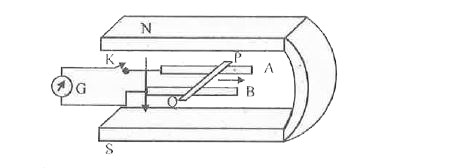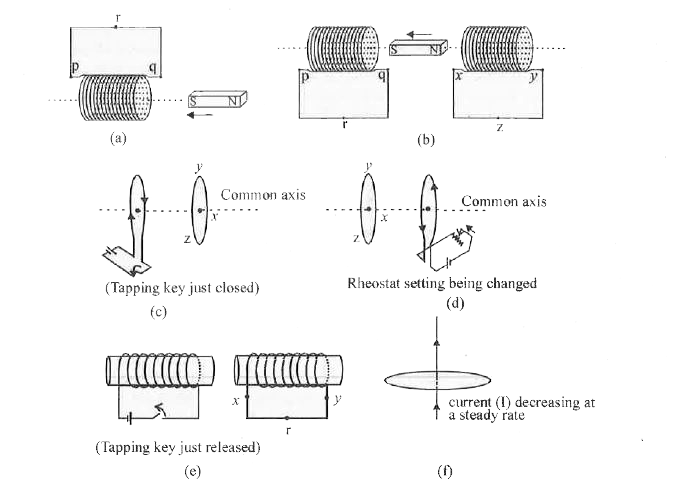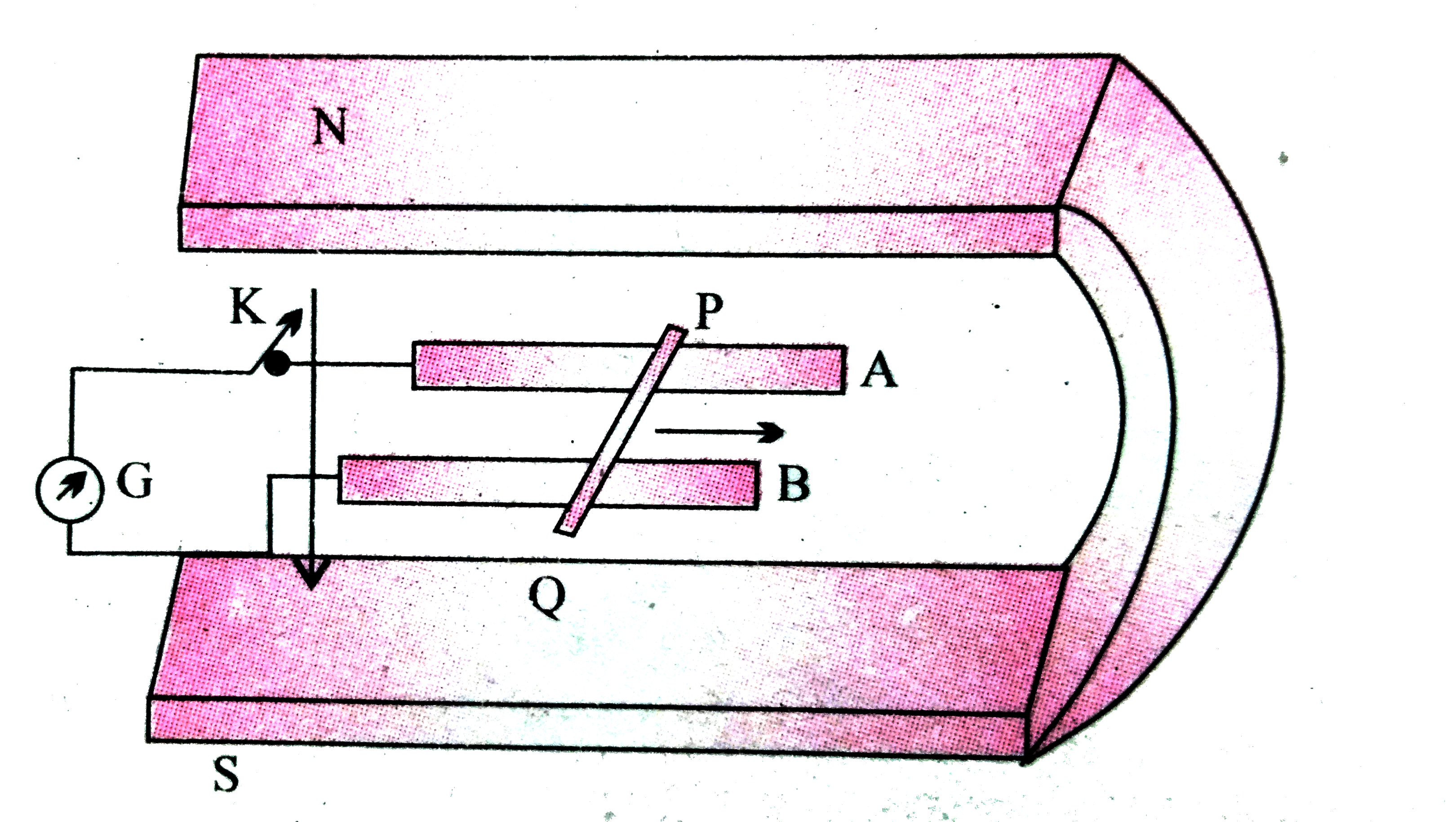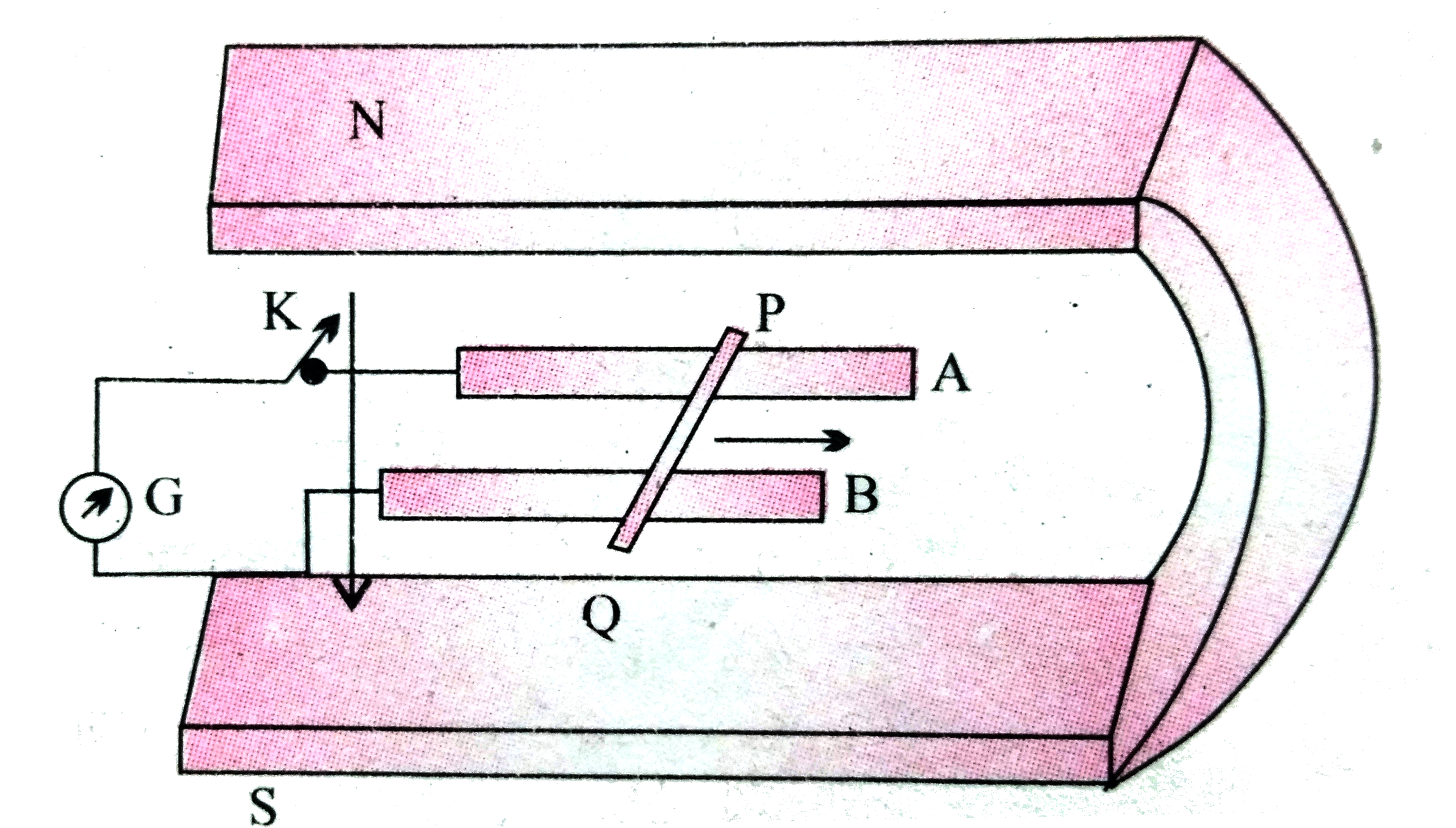Figure shows a metal rod PQ resting on the smooth rails AB and positioned between the poles of a permanent magnet. The rails, the rod and the magnetic field are in three mutually perpendicular directions. A galvonometer G connects the rails through a switch K. Length of rod = 15 cm, B = 0.50 T, resistance of the closed loop containing the rod = 9.0mΩ. Assume the field to be uniform.

a. Suppose K is open and the rod is moved with a speed of 12cms−1 in the direction shown. Give the polarity and magnitude of the induced emf.
b. Is there an excess charge built up at the ends of the rods when K is open? What if K is closed?
c. With K open and the rod moving uniformly, there is no net force on the electrons in the rod PQ eventhough they do experience magnetic force due to the motion of the rod. Explain.
d. What is the retarding force on the rod when K is closed?
e. How much power is required (by an external agent) to keep the rod moving at the same speed (=12cms−1) when K is closed? How much power is required when K is open?
f. How much power is dissipated as heat in the closed circuit? What is the source of this power?
g. What is the induced emf in the moving rod if the magnetic field is parallel to the rails instead of being perpendicular? Solution in Tamil
|ε|=vBl=0.12×0.50×0.15=9.0mV,
P positive end and Q negative end.
(b) Yes. When K is closed, the excess charge is maintained by the continuous flow of current.
(c) Magnetic force is cancelled by the electric force set-up due to the excess charge of opposite signs at the ends of the rod.
(d) Retarding force = IBl
9mV9mΩ×0.5T×0.15m
=75×10−3N
(e) Power expended by an external agent against the above retarding force to keep the rod moving uniformly at 12 cm s−1
=7.5×10−3×12×10−12=9.0×10−3W
When K is open , no power is expended
(f) I2R=1×1×9×10−3=9.0×10−3W
The source of this power is the power provided by the external agent as calculated above.
(g) Zero, motion of the rod does not cut across the field lines. [Note:length of PQ has been considered above to be equal to the spacing between the rails.]
Topper's Solved these Questions
- ELECTROMAGNETIC INDUCTIONBOOK - NCERT TAMILCHAPTER - ELECTROMAGNETIC INDUCTIONEXERCISE - EXERCISES
10 Videos
- ELECTRIC CHARGES AND FIELDS BOOK - NCERT TAMILCHAPTER - ELECTRIC CHARGES AND FIELDS EXERCISE - EXERCISES
34 Videos
- ELECTROMAGNETIC WAVESBOOK - NCERT TAMILCHAPTER - ELECTROMAGNETIC WAVESEXERCISE - Evaluation (Numerical problems)
5 Videos
Similar Questions
Predict the direction of induced current in the situations described by the following figures (a) to (f).

View SolutionWhat is the force between two small charged spheres having charges of 2×10−7Cand3×10−7C placed 30cm apart in air ?
View SolutionConsider a parallel plate capacitor whose plates are closely spaced. Let R be the radius of the plates and the current in the wire connected to the plates is 5 A, calculate the displacement current through the surface passing between the plates by directly calculating the rate of change of flux of electric field through the surface.
View SolutionFollowing figure shows a metal rod PQ resting on the smooth ralls AH and positioned between the poles of a permanent magnet. The rails, the rod and the magnetic field are in three mutual perpendicular directions. A galvanometer G connects the rails through a switch K. Length of the rod 15 cm, B 0.50 T, resistance of the closed loop containing the rod 9.0 mOmega . Assume the field to be uniform. Suppose K is open and the rod is moved with a speed of 12"cm s"^(-1) in the direction shown. Give the polarity and magnitude of the induced emf.
View SolutionFollowing figure shows a metal rod PQ resting on the smooth ralls AH and positioned between the poles of a permanent magnet. The rails, the rod and the magnetic field are in three mutual perpendicular directions. A galvanometer G connects the rails through a switch K. Length of the rod 15 cm, B 0.50 T, resistance of the closed loop containing the rod 9.0mΩ. Assume the field to be uniform.
Is there an excess charge built up at the ends of the rods when K is open? What if K is closed?
View SolutionFollowing figure shows a metal rod PQ resting on the smooth ralls AH and positioned between the poles of a permanent magnet. The rails, the rod and the magnetic field are in three mutual perpendicular directions. A galvanometer G connects the rails through a switch K. Length of the rod 15 cm, B 0.50 T, resistance of the closed loop containing the rod 9.0 mOmega . Assume the field to be uniform. With K open and the rod moving uniformly, there is no net force on the electrons in the rod PQ even though they do experience magnetic force due to the motion of the rod. Explain.
View SolutionFollowing figure shows a metal rod PQ resting on the smooth ralls AH and positioned between the poles of a permanent magnet. The rails, the rod and the magnetic field are in three mutual perpendicular directions. A galvanometer G connects the rails through a switch K. Length of the rod 15 cm, B 0.50 T, resistance of the closed loop containing the rod 9.0 mOmega . Assume the field to be uniform. What is the retarding force on the rod when K is closed?
View SolutionFollowing figure shows a metal rod PQ resting on the smooth ralls AH and positioned between the poles of a permanent magnet. The rails, the rod and the magnetic field are in three mutual perpendicular directions. A galvanometer G connects the rails through a switch K. Length of the rod 15 cm, B 0.50 T, resistance of the closed loop containing the rod 9.0mΩ. Assume the field to be uniform.
How much power is required (by an external agent) to keep the rod moving at the same speed (=12 cm s−1) when K is closed ? How much power is required when K is open?
View SolutionFollowing figure shows a metal rod PQ resting on the smooth ralls AH and positioned between the poles of a permanent magnet. The rails, the rod and the magnetic field are in three mutual perpendicular directions. A galvanometer G connects the rails through a switch K. Length of the rod 15 cm, B 0.50 T, resistance of the closed loop containing the rod 9.0mΩ. Assume the field to be uniform.
How much power is dissipated as heat in the closed circuit ? What is source of this power?
View SolutionFollowing figure shows a metal rod PQ resting on the smooth ralls AH and positioned between the poles of a permanent magnet. The rails, the rod and the magnetic field are in three mutual perpendicular directions. A galvanometer G connects the rails through a switch K. Length of the rod 15 cm, B 0.50 T, resistance of the closed loop containing the rod 9.0mΩ. Assume the field to be uniform.
What is the induced emf in the moving rod if the magnetic field is parallel to the rails instead of being perpendicular?
View Solutionचित्र में एक धातु की छड़ PQ को दर्शाया गया है जो पटरियों AB पर रखी है तथा एक स्थायी चुम्बक के ध्रुवो के मध्य स्थित है । पटरियाँ , छड़ एवं चुंबकीय क्षेत्र परस्पर अभिलंबवत दिशाओ में है ।एक गैल्वेनोमीटर ( धारामापी ) G को पटरियों से एक स्विच K की सहायता से संयोजित किया गया है । छड़ की लम्बाई 15 सेमी , B = 0.50 T तथा पटरियों , छड़ धारामापी से बने बंद लूप का प्रतिरोध = 9.0mΩ है । क्षेत्र को एकसमान मान ले ।

क्या कुंजी K खुली होने पर छड़ के सिरों पर आवेश का आधिक्य हो जायेगा ? क्या होगा यदि कुंजी K बंद कर दी जाए ?
View Solutionचित्र में एक धातु की छड़ PQ को दर्शाया गया है जो पटरियों AB पर रखी है तथा एक स्थायी चुम्बक के ध्रुवो के मध्य स्थित है । पटरियाँ , छड़ एवं चुंबकीय क्षेत्र परस्पर अभिलंबवत दिशाओ में है ।एक गैल्वेनोमीटर ( धारामापी ) G को पटरियों से एक स्विच K की सहायता से संयोजित किया गया है । छड़ की लम्बाई 15 सेमी , B = 0.50 T तथा पटरियों , छड़ धारामापी से बने बंद लूप का प्रतिरोध = 9.0mΩ है । क्षेत्र को एकसमान मान ले ।

कुंजी बंद है तथा छड़ 12 सेमी /से की चाल से दर्शायी गयी दिशा में गतिमान होने की स्थिति में छड़ पर लगने वाले अवमंदन बल का मान क्या होगा ?
View SolutionA metal rod PQ is resting on the rails A'B' and positioned between the poles of a permanent magnet. The rails, the rod and the magnetic field are in three mutually perpendicular directions. A galvanometer G connects the rails through a switch K. Length of the rod = 15 cm, B = 0.50 T, resistance of the closed loop containing the rod = 9.0 mOmega . Assume the field to be uniform. Suppose K is open and the rod is moved with a speed of 12 cm. s^(-1) in the direction shown. Give the polarity and magnitude of the induced emf.
View SolutionA metal rod PQ is resting on the rails A'B' and positioned between the poles of a permanent magnet. The rails, the rod and the magnetic field are in three mutually perpendicular directions. A galvanometer G connects the rails through a switch K. Length of the rod = 15 cm, B = 0.50 T, resistance of the closed loop containing the rod = 9.0 mOmega . Assume the field to be uniform. Is there an excess charge built up at the ends of the rods when K is open? What if K is closed?
View SolutionA metal rod PQ is resting on the rails A'B' and positioned between the poles of a permanent magnet. The rails, the rod and the magnetic field are in three mutually perpendicular directions. A galvanometer G connects the rails through a switch K. Length of the rod = 15 cm, B = 0.50 T, resistance of the closed loop containing the rod = 9.0mΩ. Assume the field to be uniform.

With K open and the rod moving uniformly, there is no net force on the electrons in thr rod PQ even though they do experience magnetic force due to the motion of the rod. Explain.
View SolutionA metal rod PQ is resting on the rails A'B' and positioned between the poles of a permanent magnet. The rails, the rod and the magnetic field are in three mutually perpendicular directions. A galvanometer G connects the rails through a switch K. Length of the rod = 15 cm, B = 0.50 T, resistance of the closed loop containing the rod = 9.0 mOmega . Assume the field to be uniform. How much power is required by an external agent to keep the rod moving at the same speed (=12cm.s^(-1)) when K is closed? How much power is required when K is open?
View Solution
